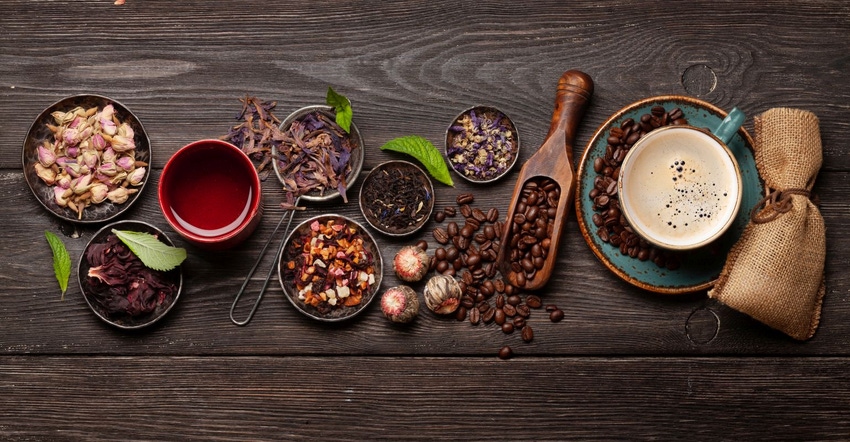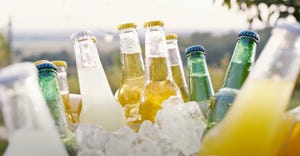Plant-based, inherently healthful and steeped in tradition, coffee and tea continue to deliver new offerings to an increasingly health-conscious beverage market.

If ever a pair of beverages were built for the current moment, it’d look a lot like the duo of coffee and tea. Plant-based, inherently healthful, steeped in tradition: One would be hard-pressed to find better vehicles for delivering functional ingredients, wellness perks and all those jazzy plant milks that keep popping up in dairy cases these days.
No wonder, then, that interest in better-for-you coffees and teas is at a boiling point. Or, as Tony Colalillo, VP and GM at Florida Food Products (FFP) – Taste, put it, “We can all agree that consumers will continue to demand coffee and tea beverages that do more than just hydrate.”
That has beverage developers brewing up all sorts of innovations: new formats, new flavor profiles, new functional adds and new ways of enjoying these timeless drinks. “The need to innovate toward functionality is prevalent today and will continue in the near future,” Colalillo concluded. “We see better-for-you demand growing along with consumers’ desire for more flavors and uniqueness.”
Tea’s halo, coffee’s rehabilitation
The fact that coffee and tea fill the better-for-you bill is only natural: Both beverages claim strong reputations for wellness straight out of the gate.
“Tea’s worn a health halo for centuries,” noted Anuhya Bhaskara, FFP’s taste R&D manager. “Clinical trials [are] now backing up its benefits in areas like cardiovascular, immune and cognitive health, and attributing them to tea’s polyphenols—catechins like EGCG [epigallocatechin gallate]—L-theanine and caffeine, theobromine and theophylline.”
Different tea types even “speak” to different concerns, added Micah Greenhill, beverage marketing director, ADM. “For example,” he said, “consumers see matcha powders and black and green teas as providing energy and supporting cognitive function via caffeine, while they associate chamomile with a perceived calming effect and yerba mate [Ilex paraguariensis] with sustained energy and antioxidants.”
In fact, tea’s virtuous image is so unimpeachable that “we see it used in other categories—like desserts and cocktails—to give them healthy connotations,” noted Kyle Newkirk, executive VP, global innovation, product development and marketing, Westrock Coffee Co.
Yet if tea’s worn its health halo for ages, coffee “has more recently earned its wings,” observed Philip Caputo, marketing and consumer insights manager, Virginia Dare.
“Back in the ’80s and ’90s,” he recalled, “a spate of studies linked coffee to higher risk for cardiovascular disease [CVD]. And coffee was often blamed for everything from stunted growth and ulcers to ‘energy addiction.’”
Not anymore. “Especially in the last five years,” Caputo continued, “the science has been more in-depth. Because of that, we’ve gained a wider view into how people engage with coffee, how it may affect them differently and what happens when they drink more or less of it.”
That science has reached consumers, who’ve “become more cognizant of coffee’s benefits beyond caffeine,” Bhaskara pointed out. She noted associations between hydroxycinnamic acids and polyphenols in coffee and reduced risk for diabetes, liver disease and certain cancers, adding that American Heart Association (AHA) research even linked coffee consumption with reduced risk for heart disease and increased life span. Her conclusion: “This turns the tables and wipes away the stigma.”
That said, Caputo emphasized, “It’s important to discern two things. One, the updated data is more about coffee ‘not being bad for you’ than going so far as to say it’s good for you—which just means we have more studying to do—and second, regardless of any data, coffee consumption worldwide has been climbing steadily. So good or ‘not bad,’ it’s a beloved beverage.”
If the halo fits…
John Quilter, VP of the proactive health global portfolio, Kerry, suggested, “These inherent health halos make coffee and tea great fits for functional formulation. Consumers are more likely to accept health benefits in categories already associated with health.”
And thanks to COVID-19, consumers increasingly value those benefits. “The megatrend we’re seeing is increased proactivity around health and an active interest in using everyday beverages as vehicles for benefits,” Quilter noted.
To put the pandemic’s effect on functional food and beverage demand in perspective, he pointed to 2021 Kerry global consumer research showing that 42% of survey respondents claimed to have increased their purchases of such products since the coronavirus struck. No wonder, then, that Euromonitor pegged the value of the global functional beverage market at US$102 billion in 2020, and predicted a compound annual growth rate (CAGR) of 3.2% through 2025, he said.
Editor’s note: This article was excerpted from an in-depth feature in the “Steeped in innovation: Coffee and tea go beyond energy – digital magazine.” Click the link to access both.
Kimberly J. Decker is a Bay Area food writer that has worked in product development for the frozen sector and written about food, nutrition and the culinary arts. Reach her at [email protected].
About the Author(s)
You May Also Like






